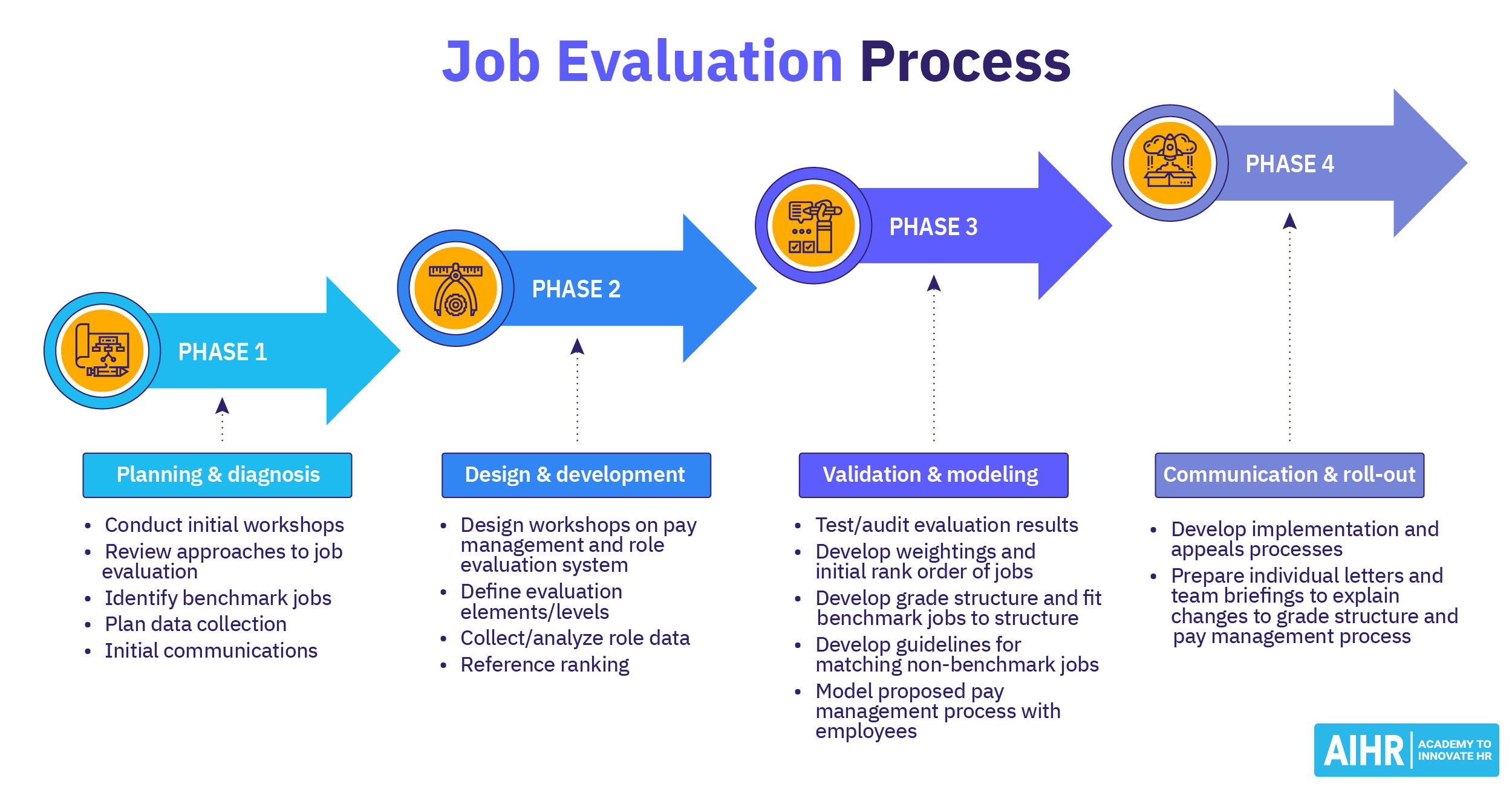Factor Comparison Method
What is the factor comparison method?
The factor comparison method is a job evaluation technique that assesses different jobs in an organization by using pre-defined compensable factors essential to each role (e.g., skills, responsibility, working conditions).
First developed by Thoman E. Hitten in the early 20th century, the method involves assigning a monetary value to each identified factor, which is then used to evaluate and rank the relative worth of each job.
When effectively implemented, it can provide a systematic approach for evaluating a wide range of jobs, along with a detailed breakdown of compensation structures across an organization.
The overall objective of the factor comparison job evaluation method is to establish fair and equitable pay grades within an organization, which can help ensure pay equity and improve employee satisfaction.

Which factors does the factor comparison method use?
The key factors typically associated with factor comparison are:
- Skill: The level of expertise, knowledge, and ability needed to effectively perform the job.
- Mental effort: The degree of cognitive ability, problem-solving, and decision-making the role involves.
- Physical effort: The amount of physical exertion and endurance the position requires.
- Responsibility: The level of authority, accountability, and supervisory management of others the job entails.
- Working conditions: The type of physical environment and any hazards or discomfort involved in the role.
HR tip
Although the above factors are commonly used, you should involve employees in identifying or reviewing the key factors associated with their specific positions. By including them in the factor comparison process, you can gain greater insight into the identified factors and build trust and transparency.
How does the factor comparison method work?
The factor comparison method typically involves the following steps:
- Selection of benchmark jobs: The first step is to select a set of benchmark jobs. These jobs should be well-defined, representative of various levels and functions within the organization, and generally stable in terms of duties and responsibilities. These jobs serve as a standard or reference for evaluating other jobs.
- Identification and definition of key factors: Identify the factors that are considered important in determining the value of a job. Common factors include skills, responsibilities, effort, working conditions, and education or experience. Clearly define each factor to ensure consistent application across all jobs.
- Ranking of benchmark jobs for each factor: Each benchmark job is ranked against each identified factor. For example, you would rank the benchmark jobs according to the level of skill required, the degree of responsibility, the amount of effort, and so on. This ranking is done independently for each factor.
- Assignment of monetary values to each factor: After ranking the jobs, assign monetary values to the levels within each factor. This involves determining how much each factor contributes to the overall job value in financial terms, such as deciding the additional pay warranted for a job requiring higher skills.
- Evaluation of all other jobs: Use the benchmark jobs as reference points to evaluate all other jobs in the organization. Compare each job’s requirements to the benchmark jobs for each factor, assign a value to each factor, and calculate the total value of the job by summing the values.
- Establishment of a job ranking and pay structure: With the evaluations complete, create a job hierarchy by grouping jobs with similar total values together. Assign similar pay grades to jobs within the same group, establishing a fair and equitable organizational pay structure.
- Review and adjustment: Finally, periodically review the factor comparison results to ensure they continue to reflect the organization’s needs and market conditions accurately. Make adjustments as necessary to keep the job evaluation system relevant and fair.
Point factor method vs. factor comparison method
The point factor method and the factor comparison method are both job evaluation techniques used to assess the relative value of jobs within an organization, but they differ significantly in their approach and application. Here’s a breakdown of the differences:
Evaluation process
Each job is divided into specific factors with pre-assigned point values.
Jobs are ranked against pre-selected benchmark jobs for each factor. There are no pre-assigned points.
Factor definition
Factors are divided into levels with assigned points.
Factors are used for comparison between jobs.
Factor weighting
Each factor is assigned a point value based on its importance to the job.
Factors are not explicitly weighted, but their importance is considered when ranking jobs against benchmarks.
Job evaluation
Jobs are assigned points based on how well they meet each factor.
Jobs are ranked against one another for each factor.
Complexity
Assigning point values makes it more complex to set up.
Less complex to set up but requires identifying and maintaining a set of benchmark jobs.
Salary implications
Points are used to determine salary ranges.
The salary range is based on market data for benchmark jobs.
Advantages and disadvantages of the factor comparison method
Advantages
- Detailed and objective analysis: This method provides a thorough analysis of jobs by breaking them down into specific factors (e.g., skills, responsibility, effort). It allows for a more objective comparison between jobs.
- Customizable to organizational needs: The factors used in the evaluation can be tailored to fit the specific needs and priorities of the organization, ensuring that the evaluation aligns with organizational goals.
- Clear differentiation of job roles: The method clearly differentiates between different job roles, making it easier to distinguish between jobs that require varying levels of skills, responsibilities, and other factors.
- Facilitates fair compensation: Comparing jobs on a factor-by-factor basis helps ensure that jobs are compensated fairly according to their value to the organization.
Disadvantages
- Complex and time-consuming: The factor comparison method is complex and can be very time-consuming, especially for large organizations with many job roles to evaluate.
- Requires expertise: This method requires a high level of expertise to identify and weigh the factors correctly. Inaccurate weighting or factor selection can lead to skewed results.
- Subjectivity in factor selection and weighting: Although it aims to be objective, the selection of factors and the assignment of weights can introduce subjectivity into the process, which might affect the fairness of the results.
- Challenging to maintain consistency: Over time, maintaining consistency in the application of this method can be challenging, especially as job roles and organizational priorities change.
- Expensive to implement: The complexity and need for expertise make this method more expensive to implement compared to simpler job evaluation methods.
Conducting job evaluation using the factor comparison method
Conducting a job evaluation using this method involves several key steps to systematically assess the relative value of different jobs within an organization. Here’s a factor comparison method example to illustrate the process:
Let’s assume you are evaluating three jobs in a manufacturing company: Machine Operator, Maintenance Technician, and Production Supervisor.
Step 1: Select benchmark jobs
For this example, we’ll use the three jobs mentioned above as our benchmark jobs.
Step 2: Identify and define key factors
We’ll use the following factors for evaluation:
- Skills
- Responsibilities
- Effort
- Working conditions
- Education/experience.
Step 3: Rank the benchmark jobs for each factor
| Factor | Machine Operator | Maintenance Technician | Production Supervisor |
| Skills | 2nd | 3rd | 1st |
| Responsibilities | 3rd | 2nd | 1st |
| Effort | 2nd | 1st | 3rd |
| Working conditions | 1st | 2nd | 3rd |
| Education/experience | 3rd | 2nd | 1st |
Step 4: Assign monetary values to each factor
Now, assign monetary values based on the rankings for each factor. Let’s assume we have the following monetary values:
- Skills: $500, $1,000, $1,500
- Responsibilities: $400, $800, $1,200
- Effort: $300, $600, $900
- Working Conditions: $200, $400, $600
- Education/experience: $100, $500, $1,000.
Step 5: Evaluate all other jobs
Using the benchmark jobs, evaluate the total value of each job:
| Job | Skills | Responsibilities | Effort | Working conditions | Education/experience | Total value |
| Machine Operator | $1,000 | $400 | $600 | $400 | $100 | $2,500 |
| Maintenance Technician | $1,500 | $800 | $900 | $200 | $500 | $3,900 |
| Production Supervisor | $1,500 | $1,200 | $300 | $200 | $1,000 | $4,200 |
Step 6: Establish a job ranking and pay structure
Based on the total values:
- Production Supervisor: $4,200
- Maintenance Technician: $3,900
- Machine Operator: $2,500.
You can now establish pay grades or salary ranges corresponding to these job evaluations.
Step 7: Review and adjust
Periodically review the jobs, factors, and assigned values to ensure the pay structure remains fair, competitive, and aligned with organizational goals.
HR tip
To help prevent bias and ensure consistency, provide job evaluators with comprehensive training on the factor comparison methodology. Consider going beyond HR teams to include stakeholders from different departments. Taking these steps can provide a broader perspective.
FAQ
1. Select benchmark jobs: Choose a few key jobs that are well-understood and accepted as benchmarks.
2. Identify key factors: Define the key factors important for evaluating jobs, such as skills, responsibilities, and working conditions.
3. Rank benchmark jobs: Rank the benchmark jobs against each key factor individually.
4. Assign monetary values: Assign monetary values to the levels of each factor based on the rankings.
5. Evaluate other jobs: Compare the benchmark jobs to other similar jobs for each factor and determine their total value.
6. Establish pay structure: Use the results to create a job ranking and set corresponding pay rates.
An example of a factor comparison involves evaluating two jobs—say, a marketing manager and a sales representative—based on factors like skills, responsibility, effort, and working conditions. Each job is ranked for each factor. For instance, if the marketing manager requires higher skills but less effort compared to the sales representative, these rankings will be reflected in the final job valuation. This method helps determine the relative worth of the jobs to establish fair compensation.
The point factor method assigns numerical values to specific job factors, while the factor comparison method ranks jobs by comparing key factors directly to determine pay. The point method is more structured, whereas the factor comparison is more comparative and flexible.









